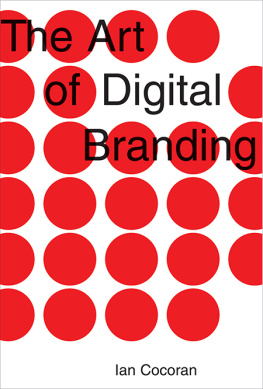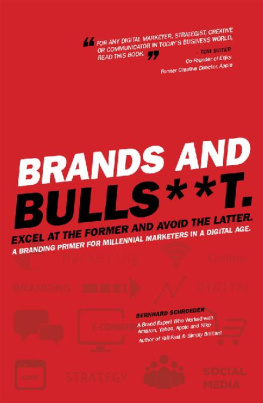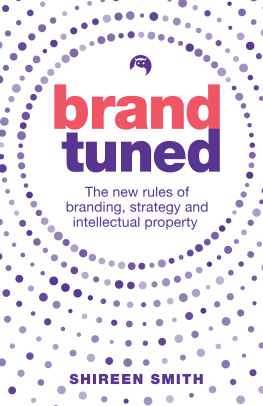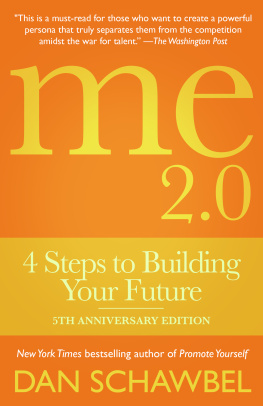
For Kate & Lucy
2007 Ian Cocoran
All rights reserved. Copyright under Berne Copyright Convention, Universal Copyright Convention, and Pan-American Copyright Convention. No part of this book may be reproduced, stored in a retrieval system, or transmitted in any form, or by any means, electronic, mechanical, photocopying, recording, or otherwise, without prior permission of the publisher.
11 10 09 08 07 5 4 3 2 1
Published by Allworth Press
An imprint of Allworth Communications, Inc.
10 East 23rd Street, New York, NY 10010
Cover design by Derek Bacchus
Interior design by SR Desktop Services, Ridge, NY
Page composition/typography by SR Desktop Services, Ridge, NY
Library of Congress Cataloging-in-Publication Data
Cocoran, Ian.
The art of digital branding / Ian Cocoran.
p. cm.
Includes index.
ISBN-13: 978-1-58115-488-7 (hardcover)
eBook ISBN: 978-1-58115-802-1
ISBN-10: 1-58115-488-7 (hardcover)
1. Internet marketing. 2. Web sitesDesign. 3. Brand name products.
4. Electronic commerce. I. Title.
HF5415.1265.C6364 2007
658.8702854678dc22
2007011449
Printed in Canada
Contents
Chapter Overviews
.
Chapter 5 OKAY, YOU BUILT IT; THAT DOESNT
MEAN THEYRE COMING
Foreword
WHAT CAUSES A FLASHY AUTOMOTIVE BRAND TO CHOOSE a demure online presence? Why would a business obscure half its product line beneath a complicated navigation system? How can a fan visit a Web site and conclude hes more passionate about the brand than the company itself? This may sound exaggerated, but it can all come horribly to life in a couple of browser clicks.
Lack of cohesion between brand position and brand identity, messages at cross-purposes with the business model, brand architecture that resembles a plate of noodles, absent customer service: none of these issues gains clarity in migrating to the Web. Certainly businesses that are not completely in sync offline can quickly unravel online, but there are a staggering number of businesses that ace offline branding and still go on to commit serious online blunders.
So whats the secret? Pointing out the obvious probably doesnt help dissipate the anxiety generated by every medium that proclaims the alarming speed of advancement and scope of the Internet. But stepping back and considering the obvious with a clear head and purpose can only help focus your online venture toward a strategic and tactical plan.
The dilemma in trying to codify digital branding is that whats written today risks being obsolete by the time it hits ink. However, there are some universal best practices for operating online. When you run out of ideas or courage, there are unlimited opportunities to browse the Net and see what works and what doesnt work. Ians best practice suggestions, illustrated by site reviews, will help take the mystery out of the mix while leaving the magic in place.
Robin Rusch
Founding Editor, brandchannel.com
New York, January 2007
A Note from the Author
IF YOU ARE READING THIS BOOK, THEN YOU ARE PROBABLY a marketer or an executive with an interest in online branding. You could also be a student whos looking to pick up some extra information before submitting a particular paper or just seeking to improve your knowledge of branding on the Web. Alternatively, you may have grabbed this title from the shelf of a bookstore in an airport or a railway station in the hope that it will pass the time on some long journey or other. Either way, thank you very much for buying this book.
The subject of digital branding has long been held as an esoteric processafter all, theres so much to consider, what with the design of a Web site, the choice of technology and imagery, and, of course, the decision as to whether or not the host organization should be selling its wares online. Add to that the complexity surrounding such extravagant concepts as search engine optimization and then throw in a couple of buzz words such as Java and Flash and its probably little wonder that the man-agement of company Web sites is frequently delegated out to the techies and the Net nerds that reside within IT.
Despite all of the fearsome rhetoric, however, I passionately believe that the subject of digital branding is anything but rocket science and that, provided that you follow a set of simple rules, it should be no more difficult or complex than your average marketing plan. Indeed, setting the science aside, digital branding is as much of an art as it is a technical skill, so creativity and innovation are key to making it work.
To that end, what I have tried to do within the pages of this book is break down the digital branding process into a series of simple modules, which, when put together, can help anyone with an open mind address the subject with confidence. In writing the conclusion, I have also attempted to articulate my belief that in todays world of ever improving technology and chaotic corporate change, Web sites can represent an emotionally intelligent medium from which businesses and organizations can reach out to their customers. When managed correctly, these sites can considerably enhance the brands they represent.
I sincerely hope that you find this book informative and useful; I also hope that it measures up to your level of expectations. Above all, however, I would hope that you will find it a light and entertaining readin the way that all good business books should be.
Acknowledgments
IN WRITING THIS BOOK, I WOULD LIKE TO ACKNOWLEDGE the help, advice, and guidance of a number of people, without whose contributions this publication would never have seen the light of day.
First, I would like to say thanks to the followingHelen Whitfield, Steve Jones, David Burgess, Scott Crighton, James Clarke, Kevin Parker, Nigel Hayes, Derek Mitchell, and Phil Hockaday, for keeping me gainfully preoccupied with business in the real world when it would have so often been easier for me to drift off into cyberspace instead. Likewise, I would like to thank Tony Corrigan for his continual humor and candor in an environment where I quite often behaved like a kid in a sweet shop and (to use his words) just couldnt help myself.
Thanks also to Mike Latham, Steve Smith, and David Jukes, for both their stoic comments and their steadfast advice, without which I probably would never have embarked on the journey of writing this book at all.
A special thank-you also goes to James Clark at Voxego.com, whose feedback on the more technical aspects of Internet design and SEO was invaluable during the early stages of writing.
Next, I would like to say a very big thank-you to my father-in-law, Dr. Gordon Ker. A founder of the Scottish Hypnosis Society and an undoubted expert in affairs of the mind, Gordon has helped ensure that this book actually progressed within the desired timescales and in keeping me motivated from conception to conclusion. He is indeed a special man and someone I will always hold in the very highest regard.
Thanks also go to my father, Paul Mann, and to his long-standing Australian confidant, Margaret OSullivan, who, as published authors, have been both influential in their guidance and invaluable in their advice. In the same regard, I would also like to thank the team at Allworth Press and, in particular, Nicole Potter-Talling, without whom this publication would never have been possible. Likewise, I would like to thank Robin Rusch, who has been tireless in her pursuit of great things for brandchannel.com and an absolute rock for all of its contributors.
Finally, I have reserved perhaps the biggest thank-you of all to my family, without whose love and blessing I would have stayed well away from this foray into authorship and, instead, would have probably just gone fishing: To my mother Maureen, for her love and best wishes, to my step-father, Doug, for his constant goodwill, and to my wife Kate and my daughter Lucy, who are always in my thoughts.
Next page









